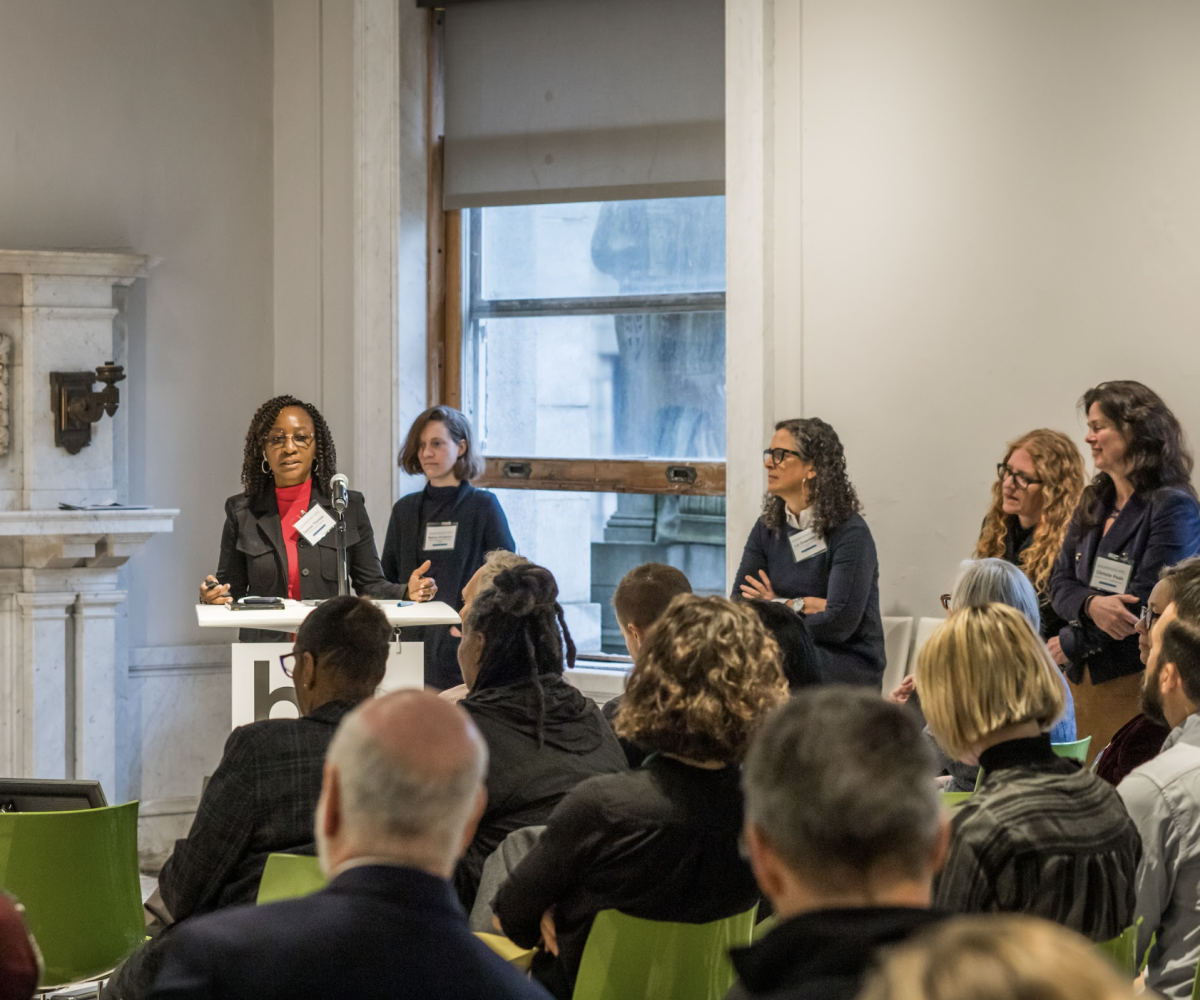WHAT IS RAINPROOF NYC?
From storms that disrupt daily life to flash floods that threaten homes and infrastructure, the impacts of heavy rainfall are becoming increasingly frequent and severe. NYC relies on 100-year-old sewers and siloed coordination across agencies and sectors. Our major rainfall events—named like Ida or Ophelia and many unnamed ones—remind us of these gaps in adapting to our new reality.
Rainproof NYC is a city-wide initiative led by Rebuild by Design to fill the gaps and lead NYC to learn to live with increasingly heavy rainfall. Since 2022, Rebuild has been combining research, global inspiration, and convening hands-on collaboration across agencies, nonprofits, communities, and experts. Rainproof NYC is charting a path to systematically transform our city into a giant sponge.
Rainproof NYC aims to be a replicable model for a collaborative, systematic approach to addressing our new reality of increasingly heavy rainfall from our home, NYC, to cities around the world.
What is our Rainproof Approach?
We define Rainproof as a systematic approach to adapting to a new reality of increasingly heavy rainfall.
We follow a simple 3-pronged strategy to Rainproof:
- Start with the most socially and physically vulnerable communities.
- Invest in multibenefit green and blue solutions.
- Where green isn’t feasible, prioritize co-benefit alternatives.
The rainproof nyc initiative
BACKGROUND & POLICY CONTEXT
Understanding Rainproof NYC starts with the concepts and policies that shape how our city manages stormwater.
For a quick glossary of core terms, an overview of NYC’s current stormwater regulations, inspiration from global case studies, and the research foundations guiding our work, CLICK HERE>>
RESEARCH & RESOURCES
We continually develop research, interactive maps, climate data, webinar recordings, and downloadable toolkits and resources.
GUIDING FRAMEWORKS
Through the Working Groups process, we collectively identified implementable recommendations, principles, and things to know about rain, designed to guide future Rainproofing efforts.
RAINPROOF NYC WORKING GROUPS
From January to June 2024, residents, nonprofits, government agencies, community organizations, schools, and the private sector worked to identify answers to Rainproof NYC.
To learn about Rainproof NYC working groups and their collective recommendations to address this growing challenge for our city, CLICK HERE>>
COMMUNITY PARTNERS
Rebuild by Design is currently working with 10 partner projects around NYC to adapt Rainproof NYC’s citywide recommendations to localized action to mitigate the impacts of heavy rain.
To learn more about these projects: CLICK HERE>>
RAINPROOF EVENT SERIES
As part of our ongoing work to address increased heavy rain, we launched a series of events to highlight innovative solutions, lessons learned from global cities, relevant research, new books, and more.
Rainproof nyc UPDATES
On October 30, 2025, a flash flood in NYC claimed two lives and damaged homes, businesses, and critical infrastructure across several neighborhoods. The storm reminded us that extreme rainfall is becoming more frequent and that everyone has a part to play in keeping our city safe.
We compiled a Rainproof actions guide for how we can each play a role in rainproofing our city. This action guide has been compiled by resources with the Rainproof NYC “Everyone Has A Role to Play” Working Group.
Rebuild by Design is thrilled to announce the launch of “Rainproof [Your Community’s Name],” a new initiative supporting 10 ongoing or new innovative projects that adopt and implement the recommendations and guiding principles from the Rainproof NYC Working Group process. Together, we are working to adapt Rainproof NYC’s citywide recommendations to localized action to mitigate the impacts of heavy rain.
To meet our community partners: CLICK HERE>>
Our Rainproof work has identified natural solutions as vital opportunities for responding to more water. To implement our findings, Rebuild by Design has initiated research and resources to understand how investing in NYC parks as climate infrastructure offers significant economic, environmental, and social returns, especially in flood-prone neighborhoods.
To view our research, data analysis, and visit a Hoboken ReslienCity Park, CLICK HERE>>
GET INVOLVED IN RAINPROOF NYC
We each have a role to play in Rainproof.
Rainproof NYC is where all stakeholders learn from each other and act collectively to tackle increasingly heavy rainfall and flash floods.The growing Rainproof NYC network brings together community groups, city officials, technical experts, policy advocates, private sector partners, educators, and more to understand and address flooding in NYC.
Ways you can get involved include:
- Stay updated on new pilot projects, events, and funding opportunities.
- Collaborate with the Rainproof NYC Network.
- Join a Rainproof Event.
- Learn from other cities in our Rainproof Series.
- Participate in or Pilot Rainproof NYC Projects.
- Share Rainproof Resources & Expertise.
As part of our ongoing work to address increased heavy rain, we launched a series of events to highlight innovative solutions, lessons learned from global cities, relevant research, new books, and more.
The “Rainproofing New York City: Recommendations from the Working Groups,” report documents the recommendations that came out of the working group process, serving as a resource for other cities that are working to address the challenge of increased heavy rainfall
Learn from our process:
We want to work with you! To get involved with Rainproof, you can email us at: info@rebuildbydesign.org.




![RAINPROOF [YOUR COMMUNITY’S NAME] RAINPROOF [YOUR COMMUNITY'S NAME]](https://rebuildbydesign.org/wp-content/uploads/elementor/thumbs/Screenshot-2025-01-28-at-12.35.24 PM-r0o7wshlwrqg2j220affwm5w7a8xbst2ouk3j0skk0.png)


![RAINPROOF [YOUR COMMUNITY’S NAME] RAINPROOF [YOUR COMMUNITY'S NAME]](https://rebuildbydesign.org/wp-content/uploads/elementor/thumbs/Screenshot-2025-01-28-at-12.35.24 PM-r0o7wshn4mib7xvi34m5hl68us0cpo1lz5nfngqtjk.png)


